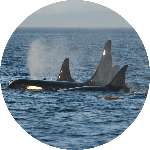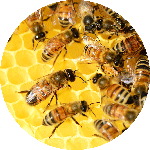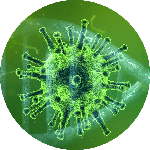Research projects
| Round I - 2016 | Round II - 2017 | Round III - 2020 | Additional |
The third round of integrative projects within the scope of the Adaptive Life programme comprises of nine PhD projects that started between July and September 2020.
A fly as best friend is an option too - The evolutionary conserved genetic pathways of sociability

PhD candidate: Sanne Lamers († 2024)
PIs:Jean-Christophe Billeter & Martien Kas
Sociability – the tendency to engage in group activities – is crucial from bacteria to humans, making it one of the most conserved aspects of life. In addition to this fundamental importance, research in the mechanisms of sociability is urgently required following the recent realisation that individual variation in human sociability correlates with morbidity and psychiatric health. A human genome-wide association study (GWAS) identified 19 candidate genes associated with sociability giving an entry into the mechanisms regulating this trait. However, given the high rate of false positive in GWAS, these genes need to be validated before further research can be initiated. Genetic validation in mice is very costly and time consuming. I therefore propose that studying Drosophila melanogaster as a simple and tractable model to study the genetics of sociability would be a great addition to studies in mice. I aim to find the extent of conservation of sociability genes between humans and Drosophila and then validate the conserved function of these genes in Drosophila and Mus musculus. Thus, I will establish Drosophila as a model organism to investigate the function and mechanisms behind sociability. Additionally, I will start elucidating the evolutionary conserved genetic pathways that lead to variation in sociability and make a start in uncovering the mechanisms in the brain that regulate social interactions.
Project discontinued
An evolutionarily conserved pathway that links sociability, sleep and memory

PhD candidate: Adithya Sarma
PIs: Robbert Havekes & Jean-Christophe Billeter
Sociability -the tendency to engage in social interactions- and sleep are widely conserved phenomena crucial to all organisms. Impairments in both these processes are associated with negative outcomes such as severe cognitive decline and early mortality. The intimate connection of sleep and sociability is deeply evolutionary conserved. In species as distant as humans, Drosophila and mice, sleep impairments affect sociability and vice versa indicating a fundamental and ancient functional link. However, we have no knowledge of the mechanisms underlying sociability’s interplay with sleep and its resultant effect on cognitive function. This prevents us from understanding how they became connected to one another and why they have such a major impact on health.
To shine light on this fundamental but poorly understood connection, I propose to investigate whether genes influencing sociability influence sleep and subsequently explore the neural circuits underlying this link. For this, I will use mice for their homology in brain organization to humans and Drosophila for their genetic tool-set to investigate if sociability genes influence sleep quality. This research will provide a platform to investigate the fundamental question of why sleep and sociability have co-evolved and has the potential to explain the recent realization that sociability has a severe impact on sleep, resulting in impaired cognitive function. The societal relevance is obvious in the current millennium, characterized by rapidly changing social environments, where many suffer from social impairments and sleep deficit.
The cool brain - How hibernators maintain neuronal integrity

PhD candidate: Maarten Hamberg
PIs: Roelof Hut, Robbert Havekes & Robert Henning
Deep hibernation is an energy-saving strategy, characterized by long torpor periods (4-20 days) of extreme metabolic suppression and low body temperature, interspaced by short arousal periods (12-16h) of euthermia and high energy expenditure. Despite extensive research, the function to which the costs of these arousals are traded-off is unknown. During torpor, hibernators build up hyperphosphorylated tau, a phenomenon associated with neurodegenerative diseases like Alzheimer’s, but in hibernators this is completely reversed during euthermic arousal. Interestingly, animals sleep most of the time during arousals, suggesting an adaptive function. However, the role of arousal sleep and the reversal of tau hyperphosphorylation are still a mystery in hibernation research. The key objectives of this hibernation proposal is to understand why torpor is regularly interrupted by arousals and whether sleep influences the reversal of tau hyperphosphorylation, and how hyperphosphorylated tau influences hibernation and arousal sleep.
We expect that hyperphosphorylated tau levels could trigger arousals to occur in time to prevent injury. Because there was no prior wakefulness, arousal sleep is an unexplained behaviour. We suggest arousal sleep plays an essential role in the reversal of tau hyperphosphorylation. An additional objective is to determine whether DNA damage during torpor induces cellular senescence in neurons or glial cells, and if this influences tau hyperphosphorylation and arousal. Recent evidence suggests senescence to drive tau hyperphosphorylation and we hypothesize therefore that it could drive this process during hibernation. The final objective is to examine if the torpor body temperature influences torpor-associated tissue remodelling. We will use the garden dormouse as model, capable of deep hibernation at various temperatures. State of the art techniques in neuroscience allow for modulation of tau hyperphosphorylation in non-model animals like the garden dormouse. Ultimately, the results from this benefits the understanding of the hibernation trade-off, and may lead to novel biomedical applications.
Ecosystem iron retention and recycling in the pelagic phase via top predators

PhD candidate: Marcos Suárez Menéndez
PIs: Per Palsboll, Klemens Eriksson & Rampal Etienne
Iron availability is the main limiting factor on the primary production in the Antarctic marine ecosystem. The “whale pump” hypothesis argues that marine mega-fauna, such as whales, indirectly boost primary production by increasing the amount of accessible iron in the pelagic phase via “recycling” (e.g., defecation and mortalities). This “whale pump” posits a positive feed-back loop, not only between whales and primary producers, but with ripple effect to higher trophic levels in the ecosystem, including commercial fish species. If this hypothesis is correct, expanding whale populations to their historic, pre-whaling levels could have far-reaching, ecosystem-wide effects; such as increasing the overall carrying capacity of the ecosystem, as well as buffering the negative effects of global warming by increasing carbon sequestration in the ocean. The plausibility of this hypothesis, and its potential effects on a changing environment, can be assessed by back-casting whale, fish, krill and zooplankton population dynamics after the Last Glacial Maximum (LGM, 15 – 20,000 years ago (kya)). Genome-level data and habitat availability changes from ecological niche modelling can be employed to assess the relative changes in habitat and species abundances as the oceans warmed. A positive feed-back loop (i.e., a whale pump) would have resulted in higher rates of change abundances than rates predicted from increased habitat availability only. This approach, by combining genomics and ecological modelling, could not only confirm the “whale pump” hypothesis but also provide fundamental, key insights into the ecosystem dynamics in the Antarctic and its likely future in response to the current global warming.
Towards an eco-evo-devo theory for the evolution of eusociality - Integrating theory, field experiments and molecular genetics

PhD candidate: Jan Kreider
PIs: Ido Pen, Leo Beukeboom & Jan Komdeur
One of evolutionary biology’s key challenges is to understand the major evolutionary transition from solitary breeding to eusocial societies with reproductive division of labour between morphologically and behaviourally distinct castes. In this project, we take up this challenge by an integrated theoretical and experimental approach. In the first part of this project, we will develop a new theoretical framework, unifying the quantitative eco-evolutionary models of kin selection theory with the mechanistic but more conceptual theoretical approach of evolutionary developmental biology. In addition to new general predictions, we aim to provide testable quantitative models which can be applied directly to suitable species that occupy the “twilight zone” between solitary living and primitive eusociality. In the second part of the project, we will conduct experimental field studies on such a species, the relatively well-studied facultatively eusocial allodapine bee, Exoneura robusta, in which solitary and social breeding are known to coexist in the same populations. By exposing bees to different ecological conditions (food availability, nest density and predation risk) we aim to discover proximate environmental triggers for eusocial behaviour and to assess the fitness consequences of different social strategies. The underlying genetic correlates of social behaviours will be explored with transcriptomics and comparative phylogenetic analyses with other (facultatively) eusocial species. Last but not least, by combining field data, molecular analyses and species-specific evolutionary models, we will quantitatively test the new theoretical predictions (1) on E. robusta, to predict the outcome of the experiments, and (2) on Halictus rubicundus, another relatively well-studied facultatively eusocial (halictine) bee species, to predict how global warming will cause its eusociality to spread north along a latitudinal cline. If successful, this highly collaborative project could provide a major step forward towards understanding the evolution of eusociality.
The role of eco-evolutionary interactions on the spread of antimicrobial resistance in pathogenic microbial communities

PhD candidate: Misshelle Bustamante Ordonez
PIs: Marjon de Vos, Sander van Doorn & Oscar Kuipers
The aim of this project is to reduce the spread of antimicrobial resistance through horizontal gene transfer (HGT) in infectious polymicrobial communities using principles from ecology and evolution. HGT is of key importance in the evolution of antibiotic resistance, as it is one of the most effective ways of transferring information between bacteria, sometimes even between different species.
Until now, HGT has been primarily studied in single bacterial populations. The effects of genetic and ecological interactions on HGT in communities of different bacterial species has not received much attention yet. The key challenge of this project is to identify eco-evolutionary principles that govern the rate of HGT, and the spread of antimicrobial resistance in communities consisting of different pathogenic bacterial species. The obtained knowledge can be used to minimize the spread of resistance via HGT, which will be a leap forward for the microbiological research field, and a first step for future patients suffering from infectious diseases.
DNA-methylation as an epigenetic clock of biological age – A new tool to study ageing and ecology & evolution of life histories?

PhD candidate: Marianthi Tangili
PIs: Simon Verhulst, Hannah Dugdale & Per Palsboll
Understanding the root cause of ageing and associated diseases is one of the major contemporary challenges of the life sciences. Individuals with the same chronological age have been found to display enormous variation in their biological age. The assessment of an individual’s biological age is therefore a vital step towards a better understanding of the ageing process, yet developing a comprehensive biomarker has proven difficult. DNA methylation (DNAm) at many genes changes with age, and recently developed compound DNAm scores correlate strongly with chronological age in humans and a few other organisms. Importantly, individuals with a high DNAm score for their age appear to have a higher biological age, as e.g. evidenced by a higher mortality in humans. However, there have been no experimental studies investigating whether manipulations that are known to affect ageing similarly affect DNAm dynamics.
Using stored longitudinal blood samples from two long-term experiments that accelerated ageing, the project aims to develop a novel DNAm score as a robust predictor of biological age of zebra finches. How DNAm scores are affected by developmental conditions, manipulated foraging conditions and investment in reproduction as well as how they relate to age-dependent mortality rate will be investigated along with the effect of sex and the heritability of site-specific DNAm patterns. The project will provide the foundation for further study of age‐related DNAm in non‐mammalian vertebrates and serve as a step towards unravelling the fundamental ageing process through identification of signature genes of biological age. It will also enable the elemental completion of an ongoing zebra finch sister experiment in the Adaptive Life program, extending it to cover the full life span of the experimental individuals.
Social determinants of evolvability

PhD candidate: Jana Riederer
PIs: Franjo Weissing & Jan Komdeur
Evolvability, defined as a system’s capacity to adapt to changing environmental conditions, is a concept that, after only recently gaining the spotlight, has since quickly emerged as a fast-growing field of research. The assessment of evolvability is crucial for facing key challenges of our time, such as climate change. Yet, evolvability research so far has concentrated on molecular and genetic studies only, disregarding other organismal features such as the mating and breeding system. In my PhD I will therefore explore the social determinants of evolvability, focusing on two research themes: the effect of sexual selection, and the effect of parental care, on evolvability. I hypothesize that under intensified sexual selection, increased evolvability through elevated mutation rates should evolve. I further predict that increased parental care affects evolvability via two distinct mechanisms, with opposing predictions: decreased selection for evolutionary innovations lowering evolvability, and heightened cryptic variation increasing evolvability.
To explore these research themes, I will use an interdisciplinary approach with three components. Firstly, I will use mathematical models and computer simulations to investigate the theoretical grounds of the hypotheses given above, establishing clear predictions. These predictions will be tested against empirical data in a comparative approach, in which I will use the degree of sexual dimorphism as a proxy for sexual selection strength, and time until offspring independence as a proxy of the degree of parental care, respectively. Such a comparative approach has the advantage of testing the generality of these ideas, as it considers a broad range of species; however, it neglects to investigate the underlying mechanisms. To round off the project I will therefore carry out fieldwork to conduct a detailed analysis of the mechanisms linking sexual selection, parental care, and evolvability in the evolutionary arms race between the brood-parasitic cuckoo finch Anomalospiza imberbis and its host species.
Combating Parkinson’s disease by modulating the activity of the kinase LRKK2 by way of passive exercise and an evolutionary approach

PhD candidate: Cargi Ahuja
PIs: Eddy van der Zee & Arjan Kortholt
Parkinson's disease (PD) is a neurodegenerative disease that affects seven to ten million people worldwide. Despite the extensive research, a cure for PD is still unavailable. Passive exercise by whole-body vibration (WBV) has shown to have positive effects on both the brain and muscular system, which makes it a potential treatment for PD. A major limitation for the use of WBV in PD is that the optimal intervention protocol remains to be determined. To provide a rational for an optimal protocol, the field needs to know first which underlying mechanism of PD is most sensitive to WBV. I propose that the leucine rich repeat kinase 2 (LRRK2) pathway should be the focus of research. LRRK2 plays an essential role in PD pathogenesis and recent data strongly suggest that LRRK2 mediates this role via the immune response. Interestingly, several studies have shown that the beneficial anti-inflammatory effects of WBV also involve the immune system.
In the current project we will characterize the cellular role of LRRK2 and the molecular effect of WBV on LRRK2-mediated signaling and PD in general. For this I want to combine molecular characterization with the power of evolution. We will use cellular models from all kingdoms of life, as well an animal model. Studying LRRK2 signaling across some animal taxa will shed light on its evolutionary context. The evolutionary perspective in view of the effect of WBV will contribute to the concept of evolutionary medicine.
